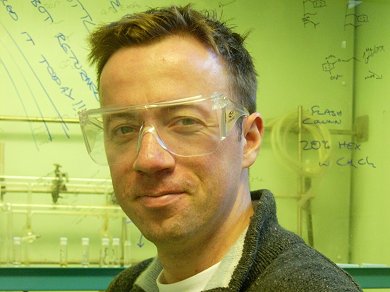Dr. Meghan Campbell, Associate Editor for ChemBioChem, talks to Professor Andrew Wilson, University of Leeds, UK, about his article that was recently accepted for publication in ChemBioChem.
You have designed new inhibitors of the interaction between HIF-1α and p300 by using a method developed in your lab. What was the inspiration behind this study?
We previously developed a new scaffold that reproduces the spatial projection of side chains made by α-helices and used this to target the p53/hDM2 protein–protein interaction [1, 2]. We were very keen to show that the approach has generic value and so looked to apply the approach to different and important targets. AstraZeneca was keen to collaborate with us and we agreed upon the HIF-1α/p300 interaction, which is mediated by α-helices, as a potential target. HIF-1 plays a central role in the hypoxic response and so represents an emerging target for potential anticancer drug development.
Using small molecules to disrupt protein–protein interactions (PPIs) is a rapidly expanding field. Why is your research particularly significant in this area?
I think the significance of our approach is that we want to establish a rule-based approach (or approaches) that can be used to develop inhibitors of PPIs. We aim to achieve this by focusing on reproducing pharmacophores of secondary structural elements found at PPI interfaces. We also recognize that it is unlikely that we will be able to get to the stage where given a structure of a PPI we can make a single molecule and so have taken a pragmatic approach of designing scaffolds that can be assembled using robust chemistry and thus, are amenable to library generation.
Rational drug design has been a goal in pharmacology for many years, what new techniques are now finally allowing this to become a reality?
Rational drug design still is and will continue to be very difficult to achieve for some time! I think a combination of factors and techniques are making the process of designing a ligand to target a given biomacromolecule more tractable—this includes a willingness to work with and optimize peptides, better virtual screening, and enhanced algorithms for docking of ligands and fragments. The acceptance of the idea that there is no “magic bullet” also helps.
What is the broader impact of this paper for the scientific community?
It seems clear from our reading of the HIF-1α literature that inhibition of its interaction with p300 is not trivial. There are some really nice papers on peptide-based inhibitors, e.g., [3], and interesting papers reporting cell-based data that indicate HIF-1α is affected by certain small molecules, but here we use biophysical methods to illustrate that the interaction can be modulated using small molecules.
How will you follow up on this discovery?
The inhibitors we obtained in this work are good, but not spectacularly potent, so we will certainly focus our attention on improving potency. In addition, a general question mark over the “proteomimetic” approach that we are using is that there isn’t strong evidence that the molecules function as proposed, both from a molecular recognition perspective and in a cellular context, so we will be continuing to try and get protein crystal structures and potent cell-permeable inhibitors.
The article they talked about:
- Small-Molecule Proteomimetic Inhibitors of the HIF-1α–p300 Protein–Protein Interaction,
George M. Burslem, Hannah F. Kyle, Alexander L. Breeze, Thomas A. Edwards, Adam Nelson, Stuart L. Warriner, Andrew J. Wilson,
ChemBioChem 2014,
DOI: 10.1002/cbic.201400009
Also mentioned:
[1] Jeffrey P. Plante, Thomas Burnley, Barbora Malkova, Michael E. Webb, Stuart L. Warriner, Thomas A. Edwards, Andrew J. Wilson, Chem Commun. 2009, 5091–5093. DOI: 10.1039/B908207G
[2] Valeria Azzarito, Panchami Prabhakaran, Alice I. Bartlett, Natasha S. Murphy, Michaele J. Hardie, Colin A. Kilner, Thomas A. Edwards, Stuart L. Warriner, Andrew J. Wilson, Org. Biomol. Chem. 2012, 10, 6469–6472. DOI: 10.1039/C2OB26262B
[3] Fei Yang, Nicholas G. Nickols, Benjamin C. Li, Georgi K. Marinov, Jonathan W. Said, Peter B. Dervan, Proc. Natl. Acad. Sci. U.S.A. 2013, 110, 15602–15607. DOI: 10.1073/pnas.1222035110




